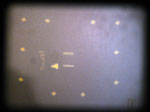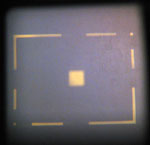The charts below show the major differences between packfilm camera models. When searching for what camera may be best is a subjective thing. With the differences outlined, it should be easier to understand why one might be considered better than another.
For a listing of every model’s specifications, and photos of camera models see the Optional Land List.
For a listing on the films available for these camera see here.
Packfilm cameras comes in three body styles:
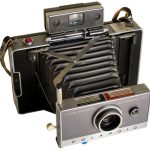
Folding Type Automatic Model 100
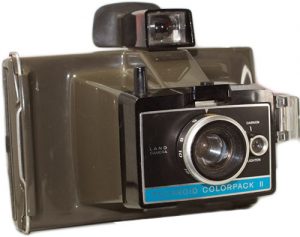
Rigid Type Colorpack II
All cameras here, except where noted, are automatic aperture priority cameras powered by batteries. Automatic packfilm cameras do not allow you to choose fstops, but instead give you set fstops with which a shutter speed is chosen by the camera for the available light. “Better” models give you more fstops to work with. Use common sense to know when you would need a tripod to avoid camera shake.
If you need to know how to load your camera there is a section for that.
For advice on Polaroid cameras see the Buying Tips page.
FOLDING |
|||||||
|---|---|---|---|---|---|---|---|
Hover over green text to see more information about certain attributes |
|||||||
|
Model |
[simple_tooltip content=’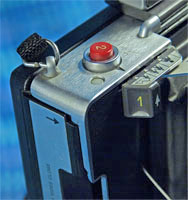 The insides of the models varies, but they are all look almost identical on the outside. The insides of the models varies, but they are all look almost identical on the outside.
The body of the camera and shutter may be of metal or plastic construction. Metal is always brushed and light. Plastic colors vary by model. The battery door and back door with rollers is always made of black, light or dark grey painted metal.’]Body[/simple_tooltip] |
[simple_tooltip content=’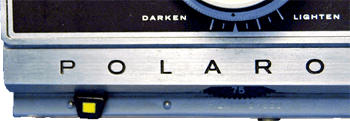 Cameras with a scene selector switch also have a film speed dial. Combining both gives you a few more shooting options for your film. Cameras with a scene selector switch also have a film speed dial. Combining both gives you a few more shooting options for your film.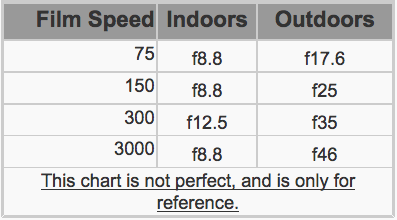
Remember to turn the L/D dial compensate for YOUR film speeds. Always set to the appropriate setting unless you are after a specific effect. Without a scene selector, your choices are only |
Finder |
[simple_tooltip content=’ Typically glass cameras have screws holding the shutter to the bellows, plastic has lock washers. Its a personal preference which is better for your photos. Plastic can be scratched, even by cleaning. Glass is more resilient to upkeep. Glass lenses are 3 element and plastic is 2′]Lens[/simple_tooltip] |
[simple_tooltip content=’Only metal body models have a tripod socket.
It is not centered and is off slightly to the side.’]Tripod[/simple_tooltip] |
[simple_tooltip content=’Some models have development timers built into the backs.
Neither of these timers are perfectly accurate after decades. But who cares, most film is self-terminating anyway. Be careful that your film isnt difficult to pull because the timer presses on the pack.’]Timer[/simple_tooltip] |
|
|
100 |
metal | [simple_tooltip content=’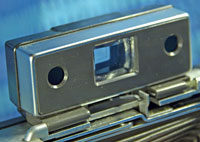 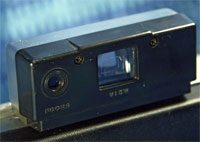 Small circular window for split-image focusing; larger viewport for parallax framing. Small circular window for split-image focusing; larger viewport for parallax framing.
Folds down when camera is closed and fits into the front cover. Can accept portrait and closeup kit goggles for non-zeiss models.’]2 window folding[/simple_tooltip] |
glass | ||||
|
101 |
metal | [simple_tooltip content=’  Small circular window for split-image focusing; larger viewport for parallax framing. Small circular window for split-image focusing; larger viewport for parallax framing.
Folds down when camera is closed and fits into the front cover. Can accept portrait and closeup kit goggles for non-zeiss models.’]2 window folding[/simple_tooltip] |
glass | ||||
|
102 |
metal/plastic | [simple_tooltip content=’  Small circular window for split-image focusing; larger viewport for parallax framing. Small circular window for split-image focusing; larger viewport for parallax framing.
Folds down when camera is closed and fits into the front cover. Can accept portrait and closeup kit goggles for non-zeiss models.’]2 window folding[/simple_tooltip] |
glass | ||||
|
103 |
plastic | [simple_tooltip content=’  Small circular window for split-image focusing; larger viewport for parallax framing. Small circular window for split-image focusing; larger viewport for parallax framing.
Folds down when camera is closed and fits into the front cover. Can accept portrait and closeup kit goggles for non-zeiss models.’]2 window folding[/simple_tooltip] |
glass | ||||
|
104 |
plastic | [simple_tooltip content=’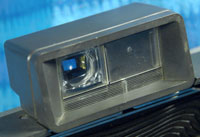 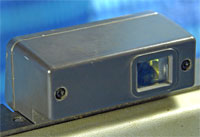 Does not have any real way to focus. An arrow moves up and down as you focus, pointing at a relative distance, while another remains stationary. Does not have any real way to focus. An arrow moves up and down as you focus, pointing at a relative distance, while another remains stationary.
You use these 2 lines to size up a human head for portrait photography. Can not accept any portrait or closeup kit.’]1 window rigid[/simple_tooltip] |
plastic | ||||
|
125 |
plastic | [simple_tooltip content=’  Does not have any real way to focus. An arrow moves up and down as you focus, pointing at a relative distance, while another remains stationary. Does not have any real way to focus. An arrow moves up and down as you focus, pointing at a relative distance, while another remains stationary.
You use these 2 lines to size up a human head for portrait photography. Can not accept any portrait or closeup kit.’]1 window rigid[/simple_tooltip] |
plastic | ||||
|
135 |
plastic | [simple_tooltip content=’  Small circular window for split-image focusing; larger viewport for parallax framing. Small circular window for split-image focusing; larger viewport for parallax framing.
Folds down when camera is closed and fits into the front cover. Can accept portrait and closeup kit goggles for non-zeiss models.’]2 window folding[/simple_tooltip] |
glass | ||||
|
210 |
plastic | [simple_tooltip content=’  Does not have any real way to focus. An arrow moves up and down as you focus, pointing at a relative distance, while another remains stationary. Does not have any real way to focus. An arrow moves up and down as you focus, pointing at a relative distance, while another remains stationary.
You use these 2 lines to size up a human head for portrait photography. Can not accept any portrait or closeup kit.’]1 window rigid[/simple_tooltip] |
plastic | ||||
|
215 |
plastic | [simple_tooltip content=’  Does not have any real way to focus. An arrow moves up and down as you focus, pointing at a relative distance, while another remains stationary. Does not have any real way to focus. An arrow moves up and down as you focus, pointing at a relative distance, while another remains stationary.
You use these 2 lines to size up a human head for portrait photography. Can not accept any portrait or closeup kit.’]1 window rigid[/simple_tooltip] |
plastic | ||||
|
220 |
plastic | [simple_tooltip content=’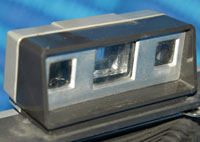 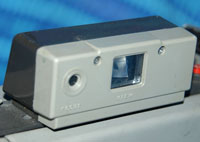 Small circular window for split-image focusing; larger viewport for parallax framing. Small circular window for split-image focusing; larger viewport for parallax framing.
Same as the folding one but the front is angled which wont allow the use of any portrait or closeup kit. |
plastic | ||||
|
225 |
plastic | [simple_tooltip content=’  Small circular window for split-image focusing; larger viewport for parallax framing. Small circular window for split-image focusing; larger viewport for parallax framing.
Same as the folding one but the front is angled which wont allow the use of any portrait or closeup kit. |
plastic | ||||
|
230 |
plastic | [simple_tooltip content=’  Small circular window for split-image focusing; larger viewport for parallax framing. Small circular window for split-image focusing; larger viewport for parallax framing.
Folds down when camera is closed and fits into the front cover. Can accept portrait and closeup kit goggles for non-zeiss models.’]2 window folding[/simple_tooltip] |
glass | ||||
|
240 |
metal | [simple_tooltip content=’  Small circular window for split-image focusing; larger viewport for parallax framing. Small circular window for split-image focusing; larger viewport for parallax framing.
Folds down when camera is closed and fits into the front cover. Can accept portrait and closeup kit goggles for non-zeiss models.’]2 window folding[/simple_tooltip] |
glass | ||||
|
250 |
metal | [simple_tooltip content=’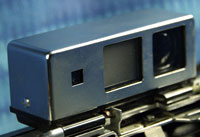 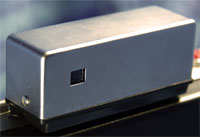 The top of the line viewfinder for Polaroid cameras. Folds down when camera is closed and fits into the front cover. The top of the line viewfinder for Polaroid cameras. Folds down when camera is closed and fits into the front cover.
Single window with split-image focusing and bright line parallax correction. There is a rare larger viewport version only found on the early model 250. Can accept portrait and closeup kit goggles for Zeiss models ONLY (usually noted by letter A).’]Zeiss[/simple_tooltip] |
glass | ||||
|
315 |
plastic | [simple_tooltip content=’  Does not have any real way to focus. An arrow moves up and down as you focus, pointing at a relative distance, while another remains stationary. Does not have any real way to focus. An arrow moves up and down as you focus, pointing at a relative distance, while another remains stationary.
You use these 2 lines to size up a human head for portrait photography. Can not accept any portrait or closeup kit.’]1 window rigid[/simple_tooltip] |
plastic | ||||
|
320 |
plastic | [simple_tooltip content=’  Small circular window for split-image focusing; larger viewport for parallax framing. Small circular window for split-image focusing; larger viewport for parallax framing.
Same as the folding one but the front is angled which wont allow the use of any portrait or closeup kit. |
plastic | ||||
|
330 |
plastic | [simple_tooltip content=’  Small circular window for split-image focusing; larger viewport for parallax framing. Small circular window for split-image focusing; larger viewport for parallax framing.
Same as the folding one but the front is angled which wont allow the use of any portrait or closeup kit. |
glass | ||||
|
335 |
plastic | [simple_tooltip content=’  Small circular window for split-image focusing; larger viewport for parallax framing. Small circular window for split-image focusing; larger viewport for parallax framing.
Same as the folding one but the front is angled which wont allow the use of any portrait or closeup kit. |
glass | ||||
|
340 |
plastic | [simple_tooltip content=’  Small circular window for split-image focusing; larger viewport for parallax framing. Small circular window for split-image focusing; larger viewport for parallax framing.
Folds down when camera is closed and fits into the front cover. Can accept portrait and closeup kit goggles for non-zeiss models.’]2 window folding[/simple_tooltip] |
glass | ||||
|
350 |
metal | [simple_tooltip content=’  The top of the line viewfinder for Polaroid cameras. Folds down when camera is closed and fits into the front cover. The top of the line viewfinder for Polaroid cameras. Folds down when camera is closed and fits into the front cover.
Single window with split-image focusing and bright line parallax correction. There is a rare larger viewport version only found on the early model 250. Can accept portrait and closeup kit goggles for Zeiss models ONLY (usually noted by letter A).’]Zeiss[/simple_tooltip] |
glass | ||||
|
355 |
metal | [simple_tooltip content=’  Small circular window for split-image focusing; larger viewport for parallax framing. Small circular window for split-image focusing; larger viewport for parallax framing.
Folds down when camera is closed and fits into the front cover. Can accept portrait and closeup kit goggles for non-zeiss models.’]2 window folding[/simple_tooltip] |
glass | ||||
|
360 |
metal | [simple_tooltip content=’  The top of the line viewfinder for Polaroid cameras. Folds down when camera is closed and fits into the front cover. The top of the line viewfinder for Polaroid cameras. Folds down when camera is closed and fits into the front cover.
Single window with split-image focusing and bright line parallax correction. There is a rare larger viewport version only found on the early model 250. Can accept portrait and closeup kit goggles for Zeiss models ONLY (usually noted by letter A).’]Zeiss[/simple_tooltip] |
glass | ||||
|
420 |
plastic | [simple_tooltip content=’  Small circular window for split-image focusing; larger viewport for parallax framing. Small circular window for split-image focusing; larger viewport for parallax framing.
Same as the folding one but the front is angled which wont allow the use of any portrait or closeup kit. |
plastic | ||||
|
430 |
plastic | [simple_tooltip content=’  Small circular window for split-image focusing; larger viewport for parallax framing. Small circular window for split-image focusing; larger viewport for parallax framing.
Same as the folding one but the front is angled which wont allow the use of any portrait or closeup kit. |
glass | mechanical | |||
|
440 |
plastic | [simple_tooltip content=’  Small circular window for split-image focusing; larger viewport for parallax framing. Small circular window for split-image focusing; larger viewport for parallax framing.
Folds down when camera is closed and fits into the front cover. Can accept portrait and closeup kit goggles for non-zeiss models.’]2 window folding[/simple_tooltip] |
glass | ||||
|
450 |
metal | [simple_tooltip content=’  The top of the line viewfinder for Polaroid cameras. Folds down when camera is closed and fits into the front cover. The top of the line viewfinder for Polaroid cameras. Folds down when camera is closed and fits into the front cover.
Single window with split-image focusing and bright line parallax correction. There is a rare larger viewport version only found on the early model 250. Can accept portrait and closeup kit goggles for Zeiss models ONLY (usually noted by letter A).’]Zeiss[/simple_tooltip] |
glass | ||||
|
455 |
metal | [simple_tooltip content=’  Small circular window for split-image focusing; larger viewport for parallax framing. Small circular window for split-image focusing; larger viewport for parallax framing.
Folds down when camera is closed and fits into the front cover. Can accept portrait and closeup kit goggles for non-zeiss models.’]2 window folding[/simple_tooltip] |
glass | ||||
|
M60 |
plastic | [simple_tooltip content=’  Does not have any real way to focus. An arrow moves up and down as you focus, pointing at a relative distance, while another remains stationary. Does not have any real way to focus. An arrow moves up and down as you focus, pointing at a relative distance, while another remains stationary.
You use these 2 lines to size up a human head for portrait photography. Can not accept any portrait or closeup kit.’]1 window rigid[/simple_tooltip] |
plastic | ||||
|
M80 |
plastic | [simple_tooltip content=’  Small circular window for split-image focusing; larger viewport for parallax framing. Small circular window for split-image focusing; larger viewport for parallax framing.
Same as the folding one but the front is angled which wont allow the use of any portrait or closeup kit. |
plastic | ||||
|
Countdown |
plastic | [simple_tooltip content=’  Small circular window for split-image focusing; larger viewport for parallax framing. Small circular window for split-image focusing; larger viewport for parallax framing.
Same as the folding one but the front is angled which wont allow the use of any portrait or closeup kit. |
plastic | ||||
|
Countdown |
plastic | [simple_tooltip content=’  Small circular window for split-image focusing; larger viewport for parallax framing. Small circular window for split-image focusing; larger viewport for parallax framing.
Folds down when camera is closed and fits into the front cover. Can accept portrait and closeup kit goggles for non-zeiss models.’]2 window folding[/simple_tooltip] |
plastic | ||||
| Below are the manual folding models. Instead of electronics and electric eyes, there is a leaf shutter.
These allow for specific speeds and fstops. You can also try to build your own. |
|||||||
|
180 |
metal | [simple_tooltip content=’  The top of the line viewfinder for Polaroid cameras. Folds down when camera is closed and fits into the front cover. The top of the line viewfinder for Polaroid cameras. Folds down when camera is closed and fits into the front cover.
Single window with split-image focusing and bright line parallax correction. There is a rare larger viewport version only found on the early model 250.
Can accept portrait and closeup kit goggles for Zeiss models ONLY (usually noted by letter A).’]Zeiss[/simple_tooltip] |
4 element glass | ||||
|
195 |
metal | [simple_tooltip content=’  Small circular window for split-image focusing; larger viewport for parallax framing. Small circular window for split-image focusing; larger viewport for parallax framing.
Folds down when camera is closed and fits into the front cover. Can accept portrait and closeup kit goggles for non-zeiss models.’]2 window folding[/simple_tooltip] |
4 element glass | ||||
RIGIDAll of these cameras have varying specs. This is just a quick synopsis of important differences and it does not cover all models. International models, found here. |
|||||||
|---|---|---|---|---|---|---|---|
|
Model |
Film Speeds |
Focus |
|||||
|
Big Swinger |
3000 ONLY | viewfinder only | |||||
|
Big Shot |
75 ONLY | fixed focus rangefinder with split image NO BATTERIES! | |||||
|
Colorpack II-V |
75/3000 | focusing aid & viewfinder | |||||
|
Minute Maker |
75 ONLY | viewfinder masks for square/rect film | |||||
|
Super Shooter |
75/3000 | focusing aid & viewfinder | |||||
| Below are cameras that ONLY take discontinued 80 series square packfilm. | |||||||
|
Square Shooter |
75 ONLY | distance finder & viewfinder | |||||
|
Zip |
3000 ONLY | distance finder & viewfinder | |||||
Reporter Style FoldingDifferences between models is quite negligible. This is just some notes about each. See the Land List for specs. |
|||||||
|---|---|---|---|---|---|---|---|
|
Model |
Notes |
||||||
|
The Reporter |
uses 80/3000 speed film but also has a “3000ER” setting allowing use of a wide open aperture |
||||||
|
EE100 |
lacks the aforementioned “3000R” setting |
||||||
|
ProPack |
ONLY model to take ProFlash electronic flash; “3000ER” is not full aperture; electronic timer |
||||||
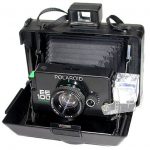
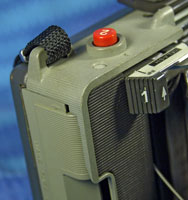
 ‘]
‘]
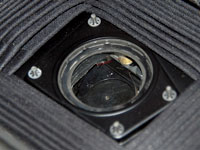 The lens elements are either plastic or glass.
The lens elements are either plastic or glass.